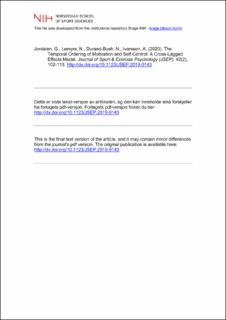| dc.contributor.author | Jordalen, Gro | |
| dc.contributor.author | Lemyre, Nicolas | |
| dc.contributor.author | Durand-Bush, Natalie | |
| dc.contributor.author | Ivarsson, Andreas | |
| dc.date.accessioned | 2021-04-28T08:46:08Z | |
| dc.date.available | 2021-04-28T08:46:08Z | |
| dc.date.created | 2020-11-12T11:47:28Z | |
| dc.date.issued | 2020 | |
| dc.identifier.citation | Journal of Sport & Exercise Psychology (JSEP). 2020, 42(2), 102-113. | en_US |
| dc.identifier.issn | 0895-2779 | |
| dc.identifier.uri | https://hdl.handle.net/11250/2740084 | |
| dc.description | I Brage finner du siste tekst-versjon av artikkelen, og den kan inneholde ubetydelige forskjeller fra forlagets pdf-versjon. Forlagets pdf-versjon finner du på www.humankinetics.com / In Brage you'll find the final text version of the article, and it may contain insignificant differences from the journal's pdf version. The original publication is available at www.humankinetics.com | en_US |
| dc.description.abstract | Mechanisms leading to cognitive energy depletion in performance settings such as high-level sports highlight likely associations between individuals’ self-control capacity and their motivation. Investigating the temporal ordering of these concepts combining self-determination theory and psychosocial self-control theories, the authors hypothesized that athletes’ self-control capacity would be more influenced by their motivation than vice versa and that autonomous and controlled types of motivation would predict self-control capacity positively and negatively, respectively. High-level winter-sport athletes from Norwegian elite sport colleges (N = 321; 16–20 years) consented to participate. Using Bayesian structural equation modeling and 3-wave analyses, findings revealed credible self-control → motivation → self-control cross-lagged effects. Athletes’ trait self-control especially initiated the temporal ordering of the least controlled types of motivation (i.e., intrinsic, integrated, and amotivation). Findings indicate that practicing self-control competencies and promoting athletes’ autonomous types of motivation are important components in the development toward the elite level. These components will help athletes maintain their persistent goal striving by increasing the value and inherent satisfaction of the development process, avoiding the debilitating effects of self-control depletion and exhaustion. | en_US |
| dc.language.iso | eng | en_US |
| dc.subject | Bayesian structural equation modeling | en_US |
| dc.subject | motivation regulations | en_US |
| dc.subject | self-control competencies | en_US |
| dc.subject | youth athlete | en_US |
| dc.title | The Temporal Ordering of Motivation and Self-Control: A Cross-Lagged Effects Model | en_US |
| dc.type | Peer reviewed | en_US |
| dc.type | Journal article | en_US |
| dc.description.version | acceptedVersion | en_US |
| dc.source.pagenumber | 102-113 | en_US |
| dc.source.volume | 42 | en_US |
| dc.source.journal | Journal of Sport & Exercise Psychology (JSEP) | en_US |
| dc.source.issue | 2 | en_US |
| dc.identifier.doi | 10.1123/JSEP.2019-0143 | |
| dc.identifier.cristin | 1847353 | |
| dc.description.localcode | Institutt for idrett og samfunnsvitenskap / Department of Sport and Social Sciences | en_US |
| cristin.ispublished | true | |
| cristin.fulltext | postprint | |
| cristin.qualitycode | 2 | |
